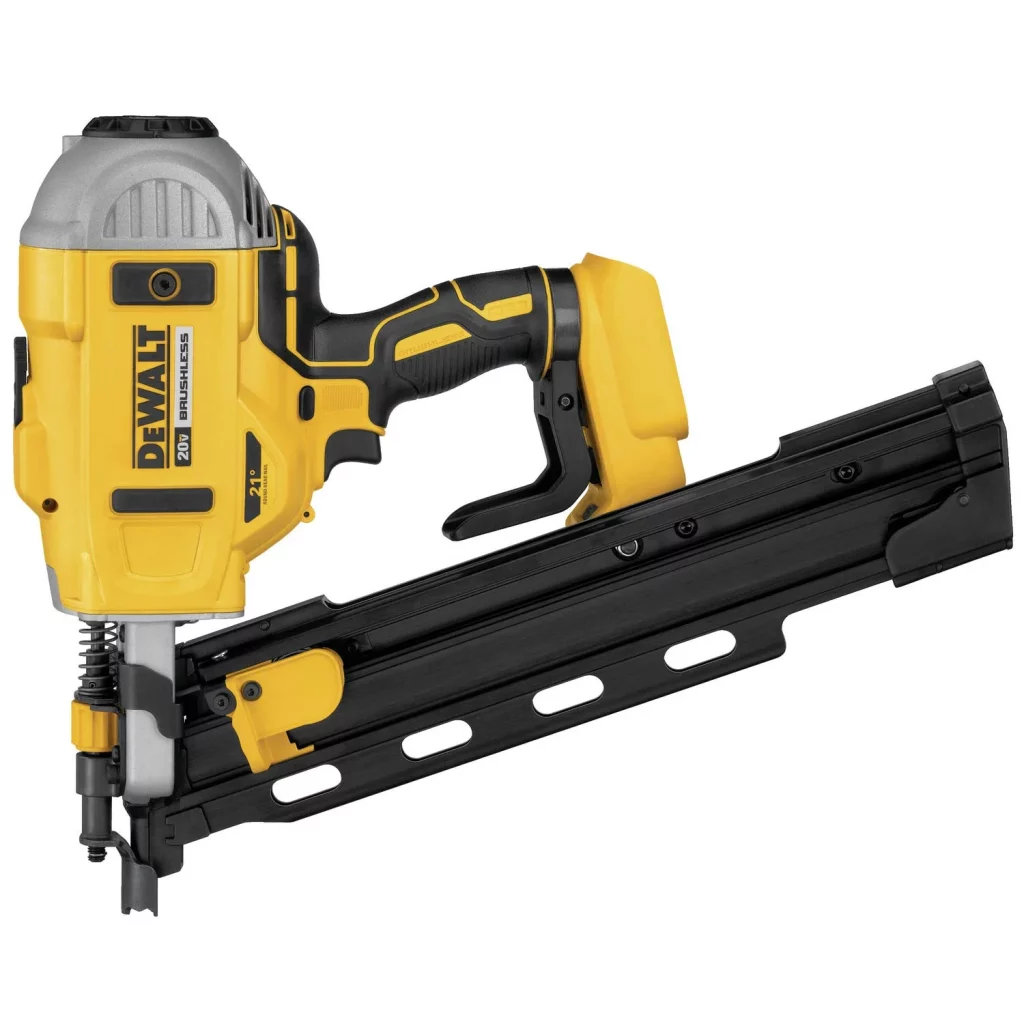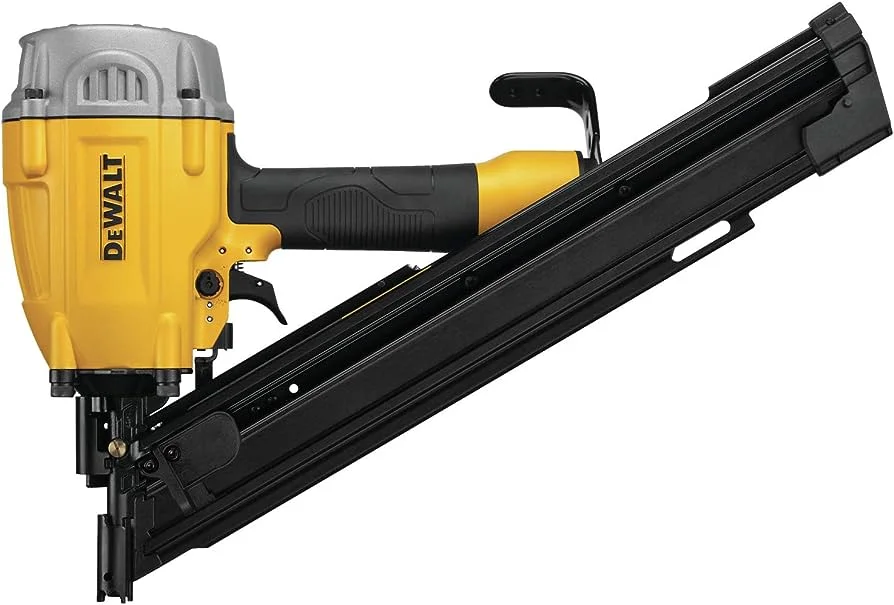What is the difference between 21 and 30 degree nailer?
Framing nailers are power tools that no professional carpenter or avid DIYer should be without. These specialized nail guns can drive dozens of nails per minute into wood framing with accuracy and ease. These nailers are designed to handle various nailer angles. But when purchasing a framing nailer, one of the key decisions is which angle magazine to choose – 21 degrees or 30 degrees. What’s the difference and which is better suited for your projects?
Framing nailers work by holding angled collated nails in a magazine that feeds into the nail gun’s drive mechanism. The angle refers to the slant of the nails in the loading strip, which can be adjusted using plastic strips or paper strips according to the degree model. There are good reasons why 21 and 30 degree models are the most common angles offered.
In this article, we will break down the key distinctions between 21 and 30 degree framing nailer models. We’ll look at the types of nails they use, their best applications, ease of use, power, and other important factors. With this guide, you’ll be able to decide whether a 21 or 30 degree framing nailer, such as the Paslode model, is the right fit for your toolbox and upcoming projects. Let’s dive in!
21° vs 30° Nail Gun Compared
| Feature | 21° Nail Gun | 30° Nail Gun |
|---|---|---|
| Nail Collated Angle | 20-22° | 30-34° |
| Nail Head Type | Full Round | Clipped/Offset |
| Nail Shank Ø | .113 to .148-inches | .113 to 131-inches * |
| Nail Sizes | 2″ to 3.5″ | 2″ to 3.5″ |
| Nail Capacity | ~60 nails | Up to 90 nails |
| Nail Collation | Plastic | Paper/Plastic |
| Power/Impact | Less force | More force |
| Precision | Excellent | Moderate |
| Best Uses | Finish nailing, trim, crafts | Framing, walls, fencing |
What Are Framing Nailers?

Framing nailers are powerful pneumatic tools designed specifically for rapidly driving nails into wood framing materials. Degree nailers, also known as degree framing nailers or degree nail guns, are an essential time-saving tool for professional carpenters and home DIYers. These tools, such as the popular Paslode brand, are a must-have for anyone looking to streamline their carpentry projects.
These degree nail guns work by utilizing compressed air to drive nails from a loaded magazine into materials like lumber, plywood, OSB, and more. Paslode nailers are a tool that allows the user to quickly and efficiently nail frames, walls, sheathing, decks, and other structural components accurately using degree nails.
Some of the most common types of framing nailers include:
- Pneumatic Framing Nailers: Most traditional nail guns are powered by compressed air hoses and compressors. Offer continuous fast nailing.
- Cordless Framing Nailers: Powered by rechargeable lithium-ion batteries for untethered convenience. More portable.
- Coil Framing Nailers: Use thin wire coil collated round head nails. Nails often at 15 degree angle.
- Stick Framing Nailers: Utilize plastic or paper-collated nail sticks loaded into the gun magazine. Includes 21 and 30 degree nailers.
- Strip Framing Nailers: The rarest type that uses a metal nail strip, also known as paper strips or thin wire strips. Increased capacity but added weight.
While operation differs across the types of framing nailers enhance productivity and make constructing wood frames simpler and faster. Choose the right degree framing nailer based on your power source, budget, and intended nailing applications.
What is a 21-Degree Framing Nailer?
A 21-degree framing nailer refers to the angle at which the nails are collated or held together in the loading magazine. Most 21-degree nailers feature an angle range of 20 to 22 degrees.

These nail guns utilize plastic collation strips that hold the nails, as opposed to wire collation or paper tapes. It has a magazine that can contain two strips of nails, totaling about 60 framing nails. The nails used are full round head nails for maximum strength. Having a narrower angle allows a 21-degree nailer to have excellent maneuverability and accuracy in tight spaces.
Some key advantages:
- Excellent for precision finish carpentry work requiring the use of woods, such as baseboards, crown molding, and door/window trim. These lumber applications often call for the use of headnails.
- A shallower angle provides more control and less potential for damaging material
- Easier to use in corners and tight spots with less powerful nail strike, the plastic strips or thin wire strips can be held by hand., the plastic strips or thin wire strips can be held by hand.
- A lower degree angle reduces the risk of wood splits in delicate molding and trim
- Full round head nails offer superior holding strength compared to clipped or offset heads
Common applications:
- Installing interior trim and molding
- Building decks and fences
- Finish exterior work like fascia, soffits, siding
- Tighter access framing and sub-floors
- Crafting furniture
- Cabinetry installation
The 21-degree nail collation paired with a compact nose design makes these ideal for detailed finish work where precision is key. While they lack the power of 30-degree models, 21-degree nailers excel at jobs requiring exact placement of nails.
What is a 30-Degree Framing Nailer?
A 30-degree framing nailer uses a magazine angle of 30 to 34 degrees to hold the nails. This steeper angle allows more powerful nail driving force compared to the 21-degree nailers.

These degree framing nailer tools typically use paper or plastic collated nails that have clipped or offset heads rather than full round. The 30-34 degree range provides excellent accessibility for nailing in tight spots in framing and structural applications. A 30-degree framing nailer uses a collated strip of nails angled at 30 degrees. The degree framing nailer can hold up to 88 nails per magazine, allowing for longer work sessions without delays.
Benefits of using a 30-degree framing nailer:
- More power and impact for dense hardwoods and thick lumber
- Faster nailing speed – can drive more nails per minute
- Holds more nails per loading – up to 90 nails
- Easier to sink nails flush into the surface
- Offset nail heads sit flush at an angle on the surface of the wood.
- Ideal for framing walls, trusses, rafters, fencing
Typical jobs for a 30-degree framing nailer:
- Framing walls with 2x4s and 2x6s
- Building wood trusses and rafters
- Deck and fence construction
- Crates, pallets, and skids
- Pole barns and timber framing
- Stair stringers
- Securing plywood and OSB sheathing
The steeper angle magazine of the degree framing nailer allows professional carpenters to make quicker work of nailing frames and structural wood components accurately. While requiring a bit more finesse, 30-degree nailers have the edge for hammering large volumes of nails.
Key Differences Between 21 Degree Framing Nailer and 30 Degree Framing Nailer?
While both offerings can handle general framing work, there are some important distinctions between these two popular angle options that impact performance and suitability to different projects.
Angle of Nail Collation
- 21-degree: Nails collated at 20-22 degrees. Allows for more precision and control.
- 30-degree: Nails collated at 30-34 degree angles. Provides more power and accessibility.
Nail Capacity and Compatibility
- 21-degree: Typically uses smaller plastic collated strips holding ~60 nails. Compatible with 2″ to 3.5″ nails.
- 30-degree: Paper or plastic collated strips holding up to 90 nails. Also works with 2″ to 3.5″ nails.
Maneuverability and Ease of Use
- 21-degree: Excellent maneuverability for detail work, thanks to its adjustable depth control. With this feature, it becomes easier to drive nails accurately using just one hand.
- 30-degree: A bit more awkward for precision nailing but provides more impact.
Cost and Availability
- 21-degree: Tend to cost a bit more than 30-degree models. Plastic collated nails are widely available.
- 30-degree: Very affordable but paper collated nails are more prone to moisture damage.
Nail Heads
- 21-degree: Full round heads offer maximum strength and holding power.
- 30-degree: Offset or clipped heads sit flushed but have slightly less grip.
Fitting into Tight Spaces
- 21-degree: Compact nose design suits tight corners and spaces better.
- 30-degree: Wider nose less suited to narrow spaces or precise applications.
Magazines & Nails
- 21-degree: Typically uses smaller plastic collated strips holding ~60 nails. Compatible with 2″ to 3.5″ nails.
- 30-degree: Paper or plastic collated strips holding up to 90 nails. Also works with 2″ to 3.5″ nails.
So in summary, 21-degree framing nailers excel at finish nailing requiring detail and precision, while 30-degree models are ideal for fast, high-volume nailing like framing or fencing. Choose the best nailer for your needs!
Choosing Between 21 and 30 Degree Framing Nailers
When deciding whether a 21-degree and 30-degree framing nailers best suit your needs, there are a few important factors to take into account:
Type of Nailer Project and Materials
Consider what you will be using the framing nail gun for most. 21-degree models are great for finishing work with softwoods, while 30-degree nailers handle dense hardwoods with ease. The nailer should match the project.
User Experience Level
If you’re an experienced carpenter, a 30-degree power may suit you. For DIYers or finishing work, a 21-degree offers more control. Pick what suits your experience.
Cost and Nail Supply
21-degree nailers tend to have a higher upfront cost. And while plastic collated nails are widely available, they can be more expensive per nail.
30-degree models are very budget friendly, though you may need to buy nails in bulk quantities. Check local availability before buying.
Local Building Codes
Make sure the nail head type – full round vs. clipped – complies with codes for your area, especially for hurricane or seismic zones.
Intended Workspaces
The nimbler size and ease of use of 21-degree nailers make them ideal if you’ll be working in tight spaces like small remodeling jobs.
Considering your unique needs and situation will help determine whether a 21 or 30-degree magazine angle is the right choice. Pick the best nailer for your upcoming projects!
Finding the Right Framing Nailer Angle for You
When it comes to driving nails quickly and efficiently, having the right framing nailer for the job is critical. Both 21 and 30-degree angle magazines have distinct advantages.
21-degree nailers excel at finish work requiring precision thanks to better maneuverability, control, and full round nails. 30-degree nailer offers increased power and faster nailing speed for structural framing jobs.
When selecting between these popular angles, it’s important to evaluate your upcoming projects and needs for the right degree framing nailer. Consider the types of materials you’ll be nailing into, your experience level, cost factors, and worksite restrictions. Matching your nailer’s angle capabilities to the application results in the best performance.
While the 21 and 30-degree models are purpose-built for different types of projects, in the hands of a knowledgeable carpenter, both can tackle a wide range of general framing applications. These models have counterparts that cater to specific uses. Don’t underestimate the versatility of these essential power tools. Whether you need a nailer for detailed trim or rapid roof truss assembly, you’ll get the best results from a framing nailer with the right angle.

